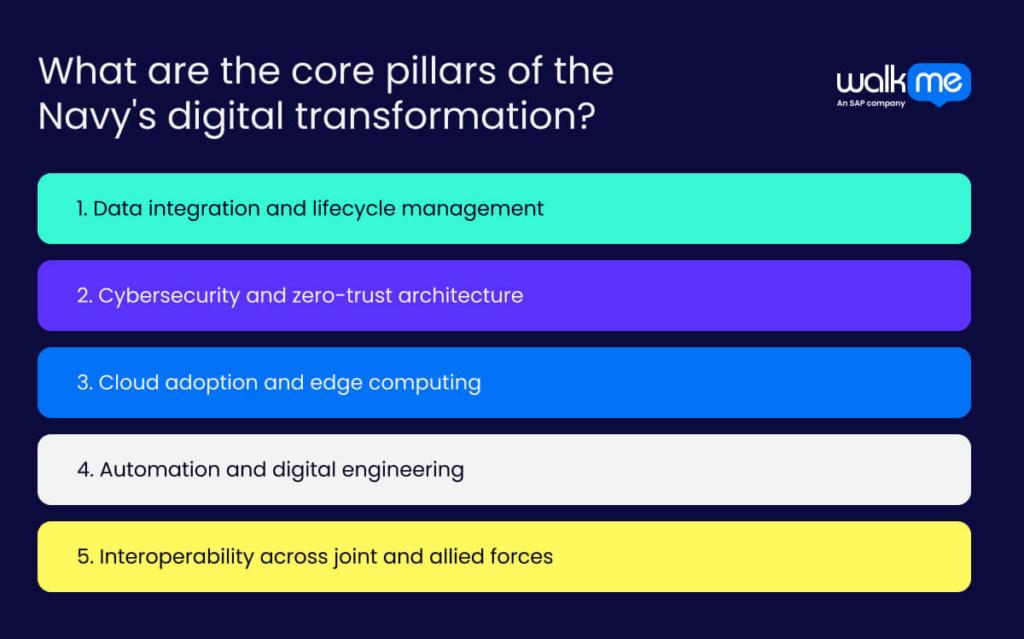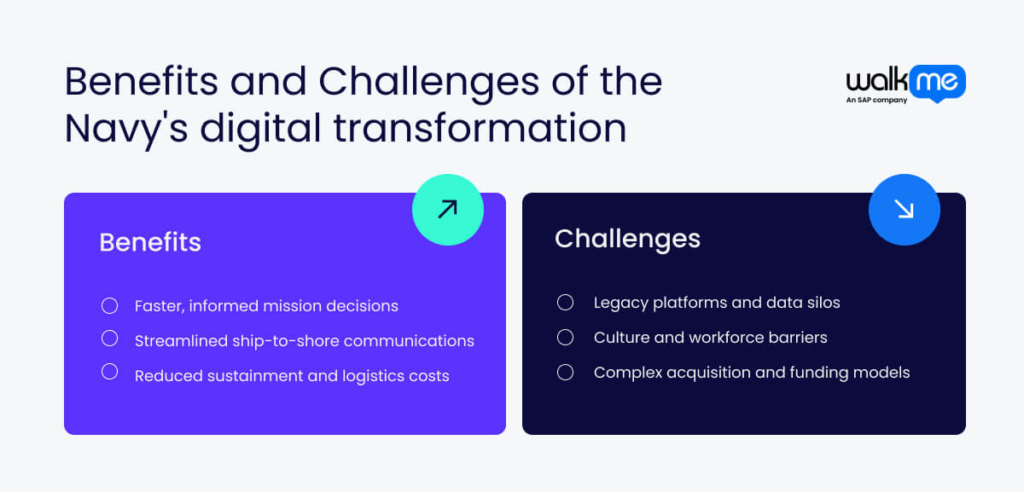The U.S. Navy will publish a detailed AI in government strategy by 2026, targeting three core areas: the kill chain, predictive maintenance, and administrative readiness.
These aren’t hypothetical goals. Machine learning (ML) is already live inside the Pacific Fleet’s Readiness Operations Center in Coronado, where natural language processing scans fleet data and supports real-time deployment decisions. AI in digital transformation reflects a broader shift toward software-defined operations across the fleet.
Digital transformation already impacts how the Navy approaches readiness, logistics, and command decision-making. This includes everything from containerized software updates on deployed ships to data integration efforts across joint forces.
The ultimate goal is a force that can adapt more quickly, respond sooner, and operate with tighter human-machine coordination at every level.
This article will examine the key aspects of the Navy’s digital transformation, focusing on its strategy, core pillars, benefits, and challenges in adopting new technologies.
Navy digital transformation is the modernization of fleet operations, logistics, and decision-making through advanced software, cloud infrastructure, and data integration.
Platforms like Project Overmatch are establishing secure, low-latency networks that link weapons systems, sensors, and operators across domains.
AI tools are being embedded into maintenance workflows, mission planning, and intelligence processing. Instead of relying on static legacy systems, the Navy is redirecting its efforts to agile, software-driven architectures that support real-time situational awareness and multi-domain coordination in contested environments.
Navy digital transformation is crucial for maintaining an operational edge in modern conflicts, where speed and adaptability determine outcomes.
At sea, data from unmanned surface vessels is now fused with intelligence feeds to provide faster targeting insights. Automating logistics through predictive analytics has reduced resupply delays for forward-deployed units.
Without system integration, decision loops remain slow and fragmented. Transformation enables the Navy fleet to respond to threats with coordinated precision, using digital tools that evolve as fast as the challenges they’re built to counter.

Now that you understand what Navy digital transformation is and why it’s important, the next step is to examine the core pillars.
Doing so will give you a clearer understanding of why these pillars are vital for the Navy’s ability to respond quickly and effectively in high-pressure situations. Recognizing how these elements work together highlights the Navy’s capacity to stay ahead of threats and maintain operational superiority.
Let’s take a closer look at the core pillars of the US Navy’s digital transformation:
Data integration and lifecycle management
In Navy operations, data is key for fast, smart decisions. The Navy connects and organizes data from all sources to make sure commanders have accurate information.
Managing data properly, from collection to storage and deletion, keeps it reliable and secure.
This system cuts delays during missions and helps predict when parts need replacing. With well-organized data, the Navy can respond quickly to changes, keeping important operations on track and improving mission results.
Cybersecurity and zero-trust architecture
Cybersecurity is more important than ever in Naval warfare, with threats constantly changing. The Navy uses zero-trust architecture to stay secure. This means every user and device is checked before access to any system, making it harder for threats to break through.
No device or user is trusted automatically, and every action is verified. This extra layer of security helps protect sensitive information and ensures that the Navy keeps security risks to a minimum, even in a digital battlefield.
Cloud adoption and edge computing
The Navy uses multi-cloud and edge computing to work faster and more efficiently. The cloud lets the Navy store important data and access it from anywhere, without being tied to one location.
Edge computing brings computing power closer to where it’s needed, such as on ships or remote bases. This lessens the time it takes to process and act on data, letting the Navy make quicker decisions and respond to threats right as soon as they arise.
Automation and digital engineering
The Navy is in a constant cycle of improving its operations by using automation technology and digital engineering. Automation helps with recurring tasks like maintenance and logistics so that people can focus on more significant work.
Digital engineering uses virtual models to test designs before they’re built, saving time and reducing mistakes. These technologies help the Navy build better equipment and systems faster, making sure everything is ready to perform at its best when needed.
Interoperability across joint and allied forces
Interoperability isn’t a new buzzword, especially for the Navy, which has invested in it for years.
The Navy focuses on creating systems that make it easy to share data and communicate with different forces, even when they use different technology.
This means that no matter what, the Navy and its partners can work together quickly and efficiently. During joint operations, this collaboration makes missions run smoother and ensures that the Navy can work seamlessly with allies in any situation.
After you’ve read, understood, and identified the core pillars of Navy digital transformation, the next step is to start implementing strategies.
This is easier said than done, given the scale of legacy infrastructure, the complexity of defense procurement cycles, and the need to coordinate across commands, contractors, and classified environments.
With that in mind, let’s take a closer look at strategies for the US Navy to accelerate digital transformation:
Attract and retain digital-first talent
The Navy can’t modernize without digital-first sailors and civilians who understand systems thinking, DevSecOps, and data pipelines. Programs like NavalX now place coders and AI engineers directly into operational teams, not behind desks.
Retention depends on meaningful work, such as training LLMs for maritime intelligence. Access to agile environments, continuous learning via NPS, and autonomy in tooling choices keep this new generation engaged and embedded.
Strengthen cyber and fleet resilience
Fleet survivability no longer depends only on armor and now hinges on data integrity and hardened networks. The Navy is embedding zero-trust protocols directly into combat systems, ensuring that even compromised nodes can’t bring down entire platforms.
Cybersecurity teams simulate live breach attempts inside Afloat Networks, using red-teaming to audit vulnerabilities at sea. Resilience also means software modularity. If one function breaks under attack, it can be replaced or isolated without halting the mission.
Advanced predictive maintenance and sustainment
Replacing parts based on calendar time wastes money and risks failure. The Navy now uses AI models trained on propulsion, radar, and hydraulic data to forecast when systems will break down to the component level.
At the Readiness Operations Center in Coronado, ML flags real-time anomalies from shipboard sensors. Instead of carrying 20 spare pumps, a carrier might now have two—because analytics shows when each one is likely to fail, and where.
Align financial systems with mission analytics
Outdated funding models slow down software delivery. The Navy integrates financial data streams with operational analytics, so budgeting reflects what’s happening at sea.
For example, if AI predicts an uptick in engine failures across a fleet class, funds can be reallocated in days, not quarters. Pilots in NAVSUP and NAVSEA now link maintenance cost data to platform availability metrics, helping leadership spend based on mission impact.
Use AI/ML for real-time threat response
AI already assists with radar signal classification, missile trajectory predictions, and swarm drone tracking. However, the focus is shifting to autonomy in edge environments, where data bandwidth is low and latency can kill.
In the Red Sea, software updates pushed mid-deployment, enabling real-time targeting improvements against UAVs. Machine learning helps ships filter noise from hostile electronic warfare, allowing faster decisions.
Expand cloud-native maritime operations
The Navy is shifting from monolithic systems to containerized, cloud-native applications that update faster than new hulls can be built. Through Project Overmatch, edge nodes aboard destroyers now run Kubernetes clusters that sync with classified DoD clouds.
Warfighters can access targeting, logistics, or maintenance software updates mid-mission. It also allows for disconnected operations—ships that go dark can still run local instances, then sync back when reconnected, thereby avoiding data loss or lag.

Understanding Navy digital transformation strategies will have taught you how specific actions, such as cloud-native operations or real-time AI responses, drive modernization at every level.
Now it’s time to look at the benefits, which will help you gauge the real-world impact of these efforts on readiness, resilience, and mission success.
Let’s take a closer look at the benefits of digital transformation in the US Navy:
Faster, informed mission decisions
The Navy now uses AI and real-time data to help commanders make quicker, smarter choices during and before missions. Instead of waiting for reports or sorting through raw information, they get clear insights fast. This helps ships respond sooner, stay safer, and carry out missions with more accuracy and confidence.
Streamlined ship-to-shore communications
New digital tools keep ships and command centers in sync, even across oceans. Messages, updates, and orders travel faster and more clearly. This means fewer mistakes, faster responses, and better teamwork between sailors at sea and the people guiding them from land.
Reduced sustainment and logistics costs
Smart software helps predict when parts will break before they do. Ships only carry what they need, saving space and money. This avoids waste, means fewer emergency fixes, and keeps everything running longer without extra costs or delays in getting supplies.
Oftentimes, the challenges of digital transformation are more important and significant than the benefits. This is especially true for the US Navy, as even small technical gaps can compromise mission readiness, delay deployments, or expose critical systems to cyber threats in contested environments.
Let’s take a closer look at the challenges of digital transformation in the US Navy:
Legacy platforms and data silos
Many Navy systems were built decades ago and don’t talk to each other. That creates delays, lost data, and extra manual work. Engineers must spend time connecting old technology rather than building new, proactive tools. Without integration, commanders can’t get a full picture fast enough to act with confidence.
Culture and workforce barriers
New tools are only useful if people trust and understand them. Many sailors and officers still rely on familiar or typical ways of working. Training is limited, and there’s often hesitation around AI or automation. Changing mindsets takes time, strong leadership, and hands-on experience that fits real mission needs.
Complex acquisition and funding models
Buying software in the Navy isn’t like downloading an app. It’s tied to years-long contracts, rigid budgets, and strict approval chains. By the time a digital tool is approved, it’s often outdated. Fast-moving tech can’t thrive under slow processes, making innovation hard to scale across ships or commands.
Given that the U.S. Navy is one of the nation’s core defense forces, it’s no surprise that digital transformation is being pursued with serious intent.
But progress and investment alone aren’t enough. The Navy must stay vigilant, continuously adapting its tools, systems, and strategies. National security depends on it, as do alliances and joint operations with partner nations, rely on it.
That means proactive investment in new technologies, smarter digital adoption methods, and ongoing evaluation of what’s working.
The Navy is beginning to understand that true transformation isn’t a one-time implementation or a checkbox; it’s an ongoing and constantly evolving mission.
FAQs
The Navy selects projects that enable it to work more efficiently and effectively. They focus on improving aspects such as communication, cyber defense, and maintaining equipment in good condition. Projects are chosen based on how much they will help with real missions and make life easier for sailors.
Autonomous systems, such as drones and robots, are transforming the way the Navy operates. These machines can perform tasks such as gathering data or patrolling without requiring human intervention. This makes operations faster, safer, and more efficient, especially in dangerous situations where it’s better not to send humans.
The Navy is updating outdated systems to enhance their compatibility with new technology. They connect older equipment to digital tools, replace outdated components, and utilize software to ensure everything runs smoothly. This helps them utilize modern technology while maintaining older systems in good working condition.

